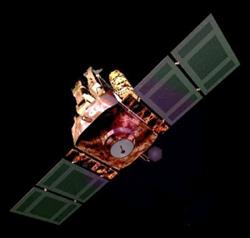In December 2005, the Solar and Heliospheric Observatory (SOHO) celebrated 10 years in space. Team members once hoped the Sun-watcher would operate for 2 years. Having exceeded all expectations, SOHO will continue to operate through December 2009.
SOHO is a collaboration between NASA and the European Space Agency (ESA). The ESA’s Science Program Committee approved funding at a May meeting. NASA’s financial commitment to the project appears to be secure after its Solar System Connection Senior Review ranked SOHO as an important mission and recommended funding — though slightly reduced — through 2010.
The observatory monitors the Sun, reporting on internal and external solar activity. Scientists are now using SOHO to recreate conditions on the far side of the Sun.
In addition to solar and space-weather observations, SOHO is a prolific comet-hunter. In August 2005, researchers discovered the 1,000th comet captured in spacecraft data. Amateur astronomers combing images on the Internet have detected many of SOHO’s comets. The observatory is responsible for discovering nearly half of the known comets orbiting the Sun. While the SOHO team knew the spacecraft would find sungrazing comets, 1,000 comets in a decade is beyond all expectations.
Slightly shifting focus, SOHO will now collaborate with NASA’s STEREO and the Japanese Space Agency’s Solar-B missions, which will launch later this year. The combination of these solar observatories will afford new and unique opportunities for improved understanding of the Sun-heliosphere system.










